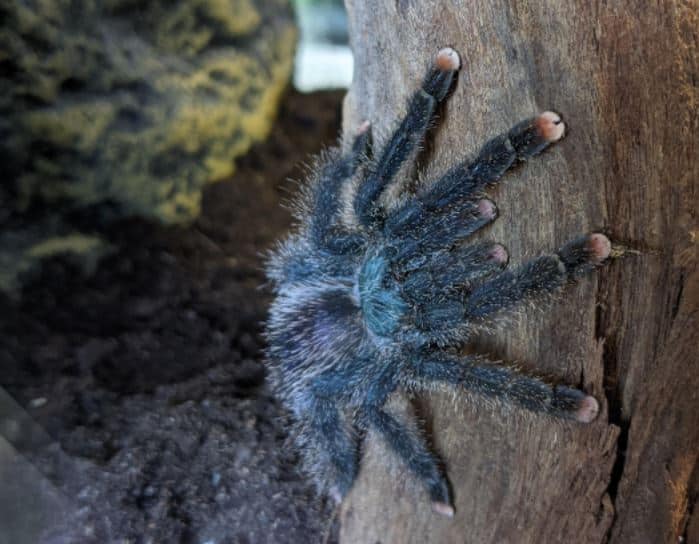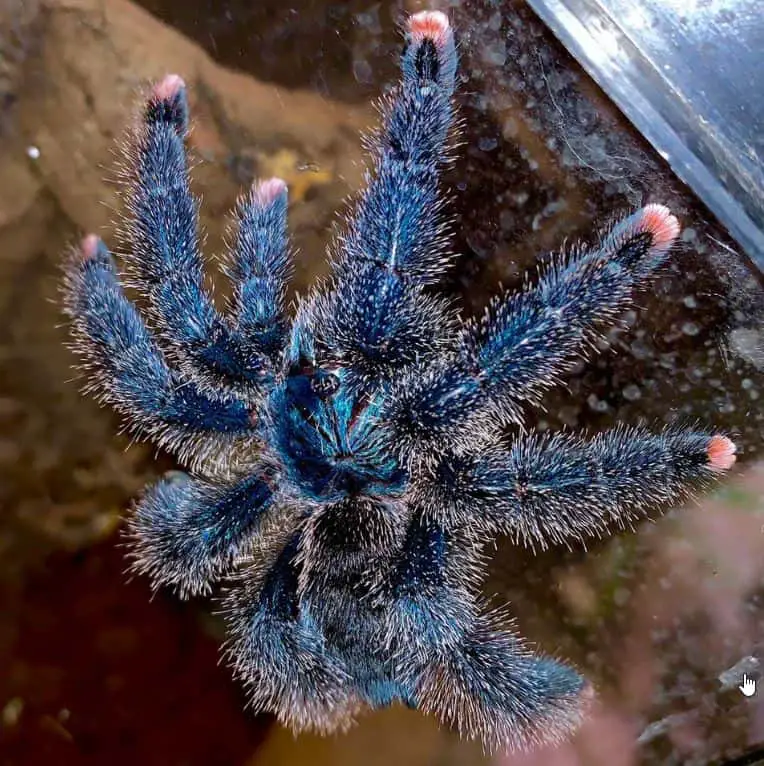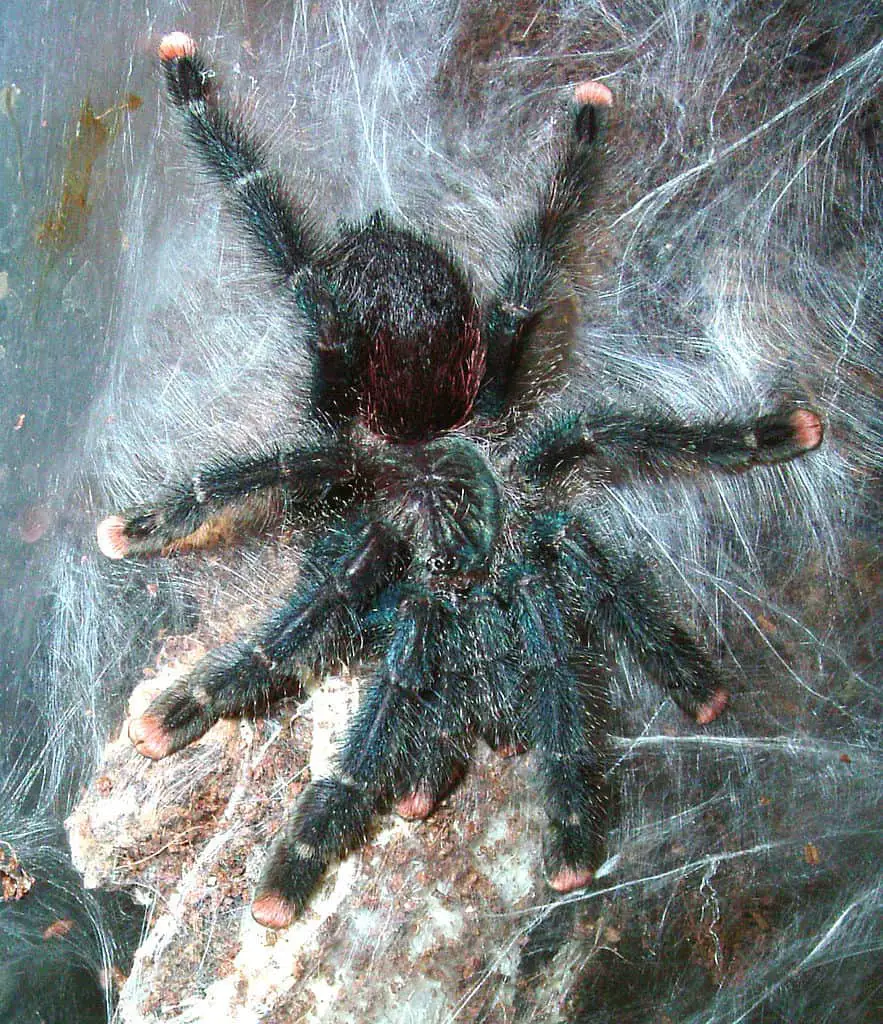The Metallic Pink Toe Tarantula is an arboreal New World tarantula species native to Colombia. It’s not as well known as some of the other species, but it’s an absolutely marvelous animal with its dark, fuzzy body and iridescent shades of blues and greens. They’re not the largest of the bunch, but they’re incredibly fast, docile, and quite active, making them good display spiders.
If you’re considering adding this species to your collection, you’ve come to the right place because today we’ll cover everything you need to know about this beautiful spider.

Metallic Pink Toe Tarantula Care Sheet
| Species Name | Avicularia Metallica |
| Family Name | Theraphosidae |
| Common Name | Metallic Pink Toe Tarantula |
| Category | New World |
| Type | Arboreal |
| Native Location | Colombia |
| Leg Span | 5 inches (13 cm) |
| Growth Speed | Medium |
| Urticating Hairs | Yes |
| Social | Solitary |
| Diet | Insects: crickets, roaches, mealworms |
| Temperature | 68 to 78 degrees Fahrenheit |
| Humidity | 70 to 80%, though ventilation is more important |
| Life Expectancy | Female: 12 years / Male: 4 years |
| Experience required | Beginner |
| Minimum tank size | 12″ x 12″ x 18″ |
Metallic Pink Toe Tarantula overview
The Metallic Pink Toe tarantula is a spider that’s native to Colombia. It lives in the trees of the rainforest, making it an arboreal tarantula.
Since they’re from the Americas, they’re a New World spider which means that they have urticating hairs which they use as a defense mechanism against predators.
Appearance & Varieties

The Metallic Pink Toe Tarantula has a dark body with pink toes. It’s very similar in appearance to the regular pink toe, although many people consider the Metallic to be prettier.
The primary difference between the two is that the metallic is often more colorful. In addition, the Metallica is larger in size, has red setae (hairs) on the abdomen, and is fuzzier.
The beautiful pink toes of this species are really unique and truly magnificent to behold when they’re walking around, which is something that they do quite a lot.
They do not look like that when they’re born. Metallic Pink Toe Slings are pink with black toes and patterning on their abdomen. It’s only when they grow that their colors start to invert; their base becomes darker and their toes become lighter.
These tarantulas are not all that big, topping out at about 5″ in leg span. Males of this species are typically smaller than females and also have duller coloration. If you want a spider that steals the show, getting a female is your best bet.
Price
Metallic Pink Toe Tarantulas are not all that expensive. Due to the fact that they’re relatively common and often recommended as beginner pets they’re easy to find. The price does depend on whether you buy a sling, juvenile, or adult, as well as whether you buy a male or a female.
Slings are the cheapest option while adults are the most expensive. The reason is that slings are harder to raise and care for. Males are cheaper than females because they have a shorter lifespan. On average, expect to pay around $35 for a sling or around $65 for an adult.
There are some other costs associated with owning a tarantula, such as buying a terrarium, food, and substrate, but these costs are very low, making the hobby very accessible.
Temperament & Behavior
The Metallic Pink Toe is a very docile species. They’re not very defensive and tolerate humans well. If they do get scared, they prefer to run rather than fight. Of course, if they feel like they’re trapped, they might lash out to defend themselves but you really have to push them to get such a reaction out of them.
They have urticating hairs which they can release to deter predators. These hairs are not very dangerous to humans unless they end up in your eyes, so do be careful when handling them. Luckily, they do not release them frequently.
Nevertheless, with New World species such as these, it’s a good idea to either wear gloves when interacting with them or their enclosure or wash your hands immediately after to avoid the urticating hairs ending up in your eyes.
They also have venom, but it’s not very potent and they do not have a tendency to bite.
They are quite heavy webbers and can create some very interesting web structures.
Because of their good nature, these tarantulas are often recommended to beginners.
They’re quite inquisitive and active spiders that spend a lot of time out in the open. This, combined with their unique coloration, makes them a great choice for a display spider.
Metallic Pink Toe Tarantula Care
Caring for these spiders is relatively straightforward. They do not need much and are very low-maintenance. With that being said, there are a few things that you should know to properly care for them.
Tank size
A tank size of 12″ x 12″ x 18″ is sufficient for an adult. Since they’re an arboreal species, height is always more important than width.
Furthermore, it’s good to choose an enclosure that has doors on the side rather than on the top. That way, you can prevent breaking their web every time you open the door and minimize the chance of escape.
Substrate
Substrate is not as important for this species because they don’t spend as much time on the ground as terrestrial species. It’s recommended to use materials such as coconut fiber, vermiculite, or peat moss (or a mix of those) as substrate as those can help keep the humidity high.
Foliage & Decor
When decorating their enclosure it’s always a good idea to try to mimic their natural habitat.
Since the Metallic Pink Toe is not a borrower, they will definitely need a hide. Multiple pieces of cork bark that extend to the top of the enclosure are a must. For the rest, you can put some other plastic plants or rocks in the enclosure to make it look more interesting.
Humidity, temperature & ventilation
Ideally, humidity should be around 70 to 80% for this species. However, this can be difficult to achieve due to the fact that ventilation is very important for them.
In the wild, they live in the trees, which naturally have plenty of winds that provide air circulation. In captivity, we can put holes on both sides of the enclosure so that the air can flow through it. Doing this will increase the circulation, but will also decrease humidity. Nevertheless, since air circulation is more important, it’s still recommended to do this.
To keep the moisture up, you can keep the substrate slightly moistened.
The temperature should be around 68 to 78 degrees Fahrenheit which is around room temperature for most people and thus easy to achieve.
Social
There are some people who’ve had short-term success housing this species with others. However, it always ended in cannibalism. As such, it’s not recommended that you try housing them communally. Keep it at one spider per enclosure to ensure that they stay safe.
Molting
The Metallic Pink Toe Tarantula will molt frequently when they’re young. They do this because they grow too big for their old skin. A few days prior to molting they will start to refuse food, this is nothing to worry about and is very normal. Once they’re molting, make sure not to disturb them as the process is quite stressful for them.
Once the molt is complete the spider will have a shiny new exoskeleton. They will refuse to eat a few days after molting because their fangs need time to harden.
Diet & feeding

Metallic Pink Toes in the wild eat a variety of different insects. In captivity, they should eat the same.
Slings should be fed flightless fruit flies. As the tarantula grows, the prey should grow with them. Fully grown Metallic Pink Toes can eat crickets, roaches, and mealworms. Make sure not to feed them food that’s larger than their abdomen. Slings should be fed once every 4 to 7 days while adults should eat once every 7 to 10 days.
The amount your spider needs depends on its size and activity levels. To know if you’re feeding your tarantula enough, keep an eye on the abdomen. If it’s shrinking, you might want to feed them a little more. On the other hand, if it’s expanding, you might want to tone down the amount you feed them a little bit.
They should only drink water. As adults, they should have a water bowl with fresh water. Make sure to put fresh water in it frequently to avoid mold and bacterial buildup. Slings and juveniles that might be too small to drink from a water bowl will get the majority of their water intake from their food but can also drink from droplets that you drip down the side of their enclosure.
Lifespan & Health
The Metallic Pink Toe tarantula typically has a lifespan of 12 years in captivity for females. Males live quite a bit shorter; about 4 years.
To keep them healthy, make sure that you keep their cage clean. This means removing uneaten food and renewing the substrate when necessary. Also, do not feed them self-caught insects since these might contain parasites.
Social
The Metallic Pink Toe is not a species that can be kept communally. Territorial and defensive, they do not tolerate other tarantulas in their territory. If you attempt to put more than one of these spiders in the same enclosure it will likely result in cannibalism, so do not attempt it.
If you’re interested in a communal tarantula setup, only do so with species that are suitable for it.
Final words: Is the Metallic Pink Toe the right Tarantula for you?
The Metallic Pink Toe Tarantula is a great species. Their beautiful iridescent blue/green shades combined with their pink toes make them a marvel to behold. This, combined with the fact that they’re so active and docile makes them great spiders for hobbyists at any experience level.
It doesn’t matter whether this is your first tarantula or your 100th, the Metallic Pink Toe is a great addition to any collection!
- How Long Do American Eskimo Dogs Live? Important Factors and Care Tips - September 29, 2023
- Do American Bulldogs Need Grooming? Essential Tips and Care Guidelines - September 29, 2023
- Do Bengal Cats Enjoy Playing? Essential Tips for Keeping Them Active - September 29, 2023